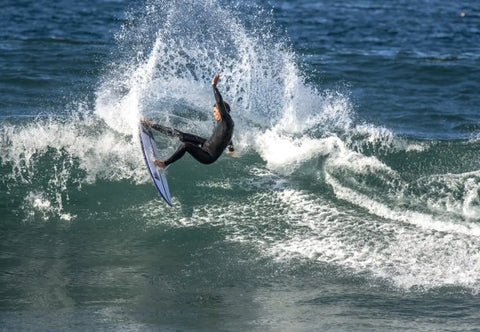The Story Behind The El Tomo Fish - Getting to Know Daniel “Tomo” Thomson
Share
The Unique History of One of Surfing’s Most Forward-Thinking Shapers
Daniel “Tomo” Thomson has become a household name in the surfboard industry, with a number of his board designs making up a part of the Firewire/Kelly Slater Designs quiver, and being ridden to great success in world tour events. But before he became a celebrity shaper, Tomo enjoyed a pretty interesting and formative childhood and career that paved the way for his future success.
Tomo grew up in New South Wales, with a father who was a free-thinking shaper, and an “uncle” who happened to be legendary visionary George Greenough. Growing up with Greenough in his dad’s shaping bay and talking story at the dinner table, Tomo quickly learned the importance of speed, style, hydrodynamics, and the twin-fin fish. He rode a wide variety of boards as a child but must of his aesthetic was centered around the fish, which instilled in him an appreciation for velocity and drive.
Tomo quickly became a standout surfer, dominating sessions and refining his style at the world-class right-hand point breaks near his childhood home. In the meantime, he was also becoming an adept shaper, apprenticing under his father and Greenough while also working on his own new designs. Tomo began to mainstream attention from the media in his mid-20s, being profiled by Surfer Magazine and heralded as one of the best surfer/shapers in the industry. Around this time, “retro” boards were starting to enjoy a resurgence in popularity, particularly in places such as California. Finding himself in demand on the West Coast, Tomo relocated to California to fill the local demand for his fish shapes.
style at the world-class right-hand point breaks near his childhood home. In the meantime, he was also becoming an adept shaper, apprenticing under his father and Greenough while also working on his own new designs. Tomo began to mainstream attention from the media in his mid-20s, being profiled by Surfer Magazine and heralded as one of the best surfer/shapers in the industry. Around this time, “retro” boards were starting to enjoy a resurgence in popularity, particularly in places such as California. Finding himself in demand on the West Coast, Tomo relocated to California to fill the local demand for his fish shapes.
In the meantime, Tomo was busy experimenting with a whole different approach to surfboards—one that was first revealed to the world through his early avant-garde designs, which somewhat resembled a kiteboard with their straight rails and chopped off noses. He continued with his experimentation, applying the principles of reduced swing weight from chopped noses and his “quad inside single concave” tail bottom contours in future designs.
The Sci-Fi ended up breaking the Internet when Stu Kennedy rode one to an impressive result at Snapper Rocks, seemingly surfing on an extra gear during the event. Around this time, Kelly Slater bought stock in Firewire and started his own line of surfboards, Slater Designs, which would soon join the Firewire family. Slater quickly brought Tomo on as one of his resident shapers, and Tomo’s Sci-Fi, Omni, and Cymatic quickly became household names. He expanded his quiver with the Evo and the Classic Tomo Jetfighter Fish, which eventually became the El Tomo Fish. For bigger and more powerful waves, he designed the Hydronaut, which ultimately gave birth to the Hydroshort, a smaller board for weaker waves that maintain a number of the Hydronaut’s design features.

Daniel Thomson on the El Tomo, shot by Jon Foster.
All of Tomo’s boards bear the distinctively recognizable signature of a free-thinking shaper who isn’t afraid to look outside of the box. And although many might dismiss other shapers with “weird” boards, the amazing thing about Tomo is how he backs up his shaping with his world-class surfing. Tomo could easily have had a successful career as a professional surfer, but luckily for the rest of us he wanted to share more than just his surfing with us—he wanted us all to have a chance to experience the speed and joy that comes from a well-designed, space-age surfboard.

